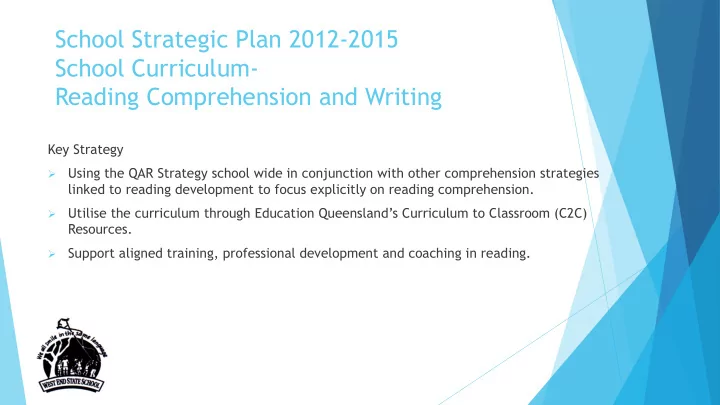

School Strategic Plan 2012-2015 School Curriculum- Reading Comprehension and Writing Key Strategy Using the QAR Strategy school wide in conjunction with other comprehension strategies linked to reading development to focus explicitly on reading comprehension. Utilise the curriculum through Education Queensland’s Curriculum to Classroom (C2C) Resources. Support aligned training, professional development and coaching in reading.
Key Performance Indicators: 100% of students above National Minimum Standards (NMS) in all areas of NAPLAN with over 50% in the Upper 2 Bands. (U2B) There has been a focus on core reading strategies using performance data e.g. PM Benchmarks and Informal Prose Inventory (IPI’s) from Prep to Year Six. Identified targets for school and student improvement, short and long term. Aligned data collection and analysis with School Assessment Schedule. Aligned and allocated resources to the identified reading strategies, to meet student needs and learning priorities.
2012 focus – Question Answer Relationships – (QAR) A tool used as a Reading/Comprehension Strategy Professional Development in Pupil Free Days Reading strategies in the Early Years. Question Answer Relationships (QAR) introduced to staff QAR: Development of whole school QAR Posters. Common metalanguage for asking and describing questions. Learn to answer questions. Generate quality questions to lead class discussions
2013 Focus – Guided Reading - QUT Guided Reading Action Research Project 2013 – 2015 Aim - To improve school wide reading comprehension strategies through Guided Reading (incorporating, but not limited to, QAR) Professional Development Diagnostic Assessments of Reading – Revisiting of PM Benchmarking and introduction of Informal Prose Inventory (IPI) Teachers collect Data on student reading behaviours, strategies, abilities and comprehension skills. This data is then used to inform planning and teaching for individual and groups of students - ensuring DIFFERENTIATION.
Coaching in Guided Reading Coaching Explicit teaching of reading comprehension strategies for learning to read and reading to learn To develop core metalanguage for teachers and aides and students to develop a language bank for effective teaching and learning. Building teacher capacity in Guided Reading pedagogy. Gradual release of responsibility. (Modelling for staff by coaches) Analysis of teacher practice and planning for teacher improvements and training needs.
Comprehension focus through Guided Reading Introduction of Guided Reading in the classroom using evidence based pedagogy – Fountas and Pinnell used as a framework to develop our own WESS practice. Year 3, 4, 5, 6 focus : 2X 2hr blocks - teachers taken offline. 5 week block in class support: 2X 1hr per week in class support- through coaching, modelling and feedback. Pro-active Workplace Planning – training of dedicated teacher aides specifically for Guided Reading.
2013 – continued Resources $15 000 Budget from P & C allowed for purchasing of Home Reading Program and levelled books. Comprehension Strategy resources – Stars and Cars, Sheena Cameron, Comprehension Boxes. QUT Guided Reading Action Research Project 2013 – 2015 To improve school wide reading comprehension strategies through Guided Reading.
2014 Continuing and refining Guided Reading coaching and practices Professional Development Guided Reading and comprehension strategies - continued Professional development of staff and coaches. (Pupil Free Day) With the collaboration of current research trends from: Sheena Cameron – Comprehension Strategies Taffy Raphael - Question Answer Relationships Fountas and Pinnell - Guided Reading and when these Question/Strategies would be incorporated throughout the Guided Reading Process.
2014 continued Coaching Staff in Prep, Year 1,2 and year 7, trained in Guided Reading Process. - Teachers taken offline. 5 week block in class support 2X 1hr per week in class support. Through coaching, modelling and feedback. Pro-active Workplace Planning – training of Prep teacher aides for Guided Reading. Feedback to coaches – was that there was increased confidence and understanding in how to teach Reading Strategies. Feedback was collected, analysed and shared by coaches and QUT researchers to use for forward planning in 2015.
2014 continued Resources: Through consultation with staff and SSP Reading and Comprehension Committee – devised a Placemat outlining how to plan, devise and implement a Guided Reading at West End State School with links to QAR and Comprehension Strategies. Magic 100 Words – exposing children to high frequency words to develop a bank sight words (sight vocabulary) which in turn develops fluency leading to greater comprehension. Resourcing – resources which focus on explicit teaching of comprehension strategies were purchased. Training coaches off campus and returning to train staff at WESS.
2014 West End State School SSP READING COMMITTEE, devised a common and consistent approach to the teaching of reading, and including QAR comprehension strategies. Staff and students became familiar with the metalanguage associated with Comprehension – from Prep to Year Six . Learn to Read (early years ) Read to Learn (greater focus on Comprehension) Teacher focus Teacher Focus: Comprehension Language experiences Fluency and phrasing Phonemic awareness Use of Text Structures Phonological awareness Use f Language features Concepts about print Broad deep vocabulary Vocabulary Using print features Fluency Comprehension Using the following Comprehension Strategies Activating prior knowledge Teaching the following Decoding Strategies: Self-monitoring Look at Pictures Predicting Get your mouth ready to stretch sounds Identify detail/ fact and opinion Making connections (Main idea) Look for chunks Visualising Re-read Inferring Read-on and go back Summarising (sequencing) Synthesising (compare and contrast) Cross Check – Skimming and scanning Does it look right? 1. Build vocabulary Knowledge Does it sound right? 2. Does it make sense? 3.
2015 - Consolidation and implementation of staff and student feedback to improve practice Consolidation of Guided Reading and Comprehension Strategies using QAR. Implementing ideas and changes from staff and student feedback from 2014 Revisiting Guided Reading and QAR in professional development on PFD Devised and shared Signature Statement linking to the Department of Training (DET)
Recommend
More recommend